Round The World and other travels
A frequent flyer's collection of trip diaries
This is: New Year in India (2016/17)
Fort Kochi and Mattancherry
 |
| ABOVE: Kerala's bold claim |
An early rise was very much the order of the day today, as we had booked a three-hour morning walking tour of the Fort Kochi and Mattancherry districts with Carnival Tours. After breakfast at Mosaic, we had a quick, convenient, hassle-free and great-value transfer to Fort Kochi using Uber - a fantastic way of getting around in Kochi. We briefly met with Peter from Carnival, who introduced us to our guide for the morning. As we were in fact the only customers, it turned out to be a private tour.
Our guide explained that, in order to understand Fort Kochi, we needed to bear in mind that the area was ruled successively by the Portuguese, the Dutch and the British. Nowhere was this better illustrated than at our first stop, St Francis CSI Church. (CSI = Church of South India) Dating from 1503, it is the oldest European-built church in the whole of India. It was originally Catholic, but when the Dutch invaded and threw out the Portuguese, it was converted to Protestant. Then when the British in turn displaced the Dutch, it became Anglican, and has remained so ever since. The building contains the original tomb of Vasco da Gama, although his body has long since been removed to Lisbon.
| RIGHT: The story of St Francis Church reflects the history of Fort Kochi itself |
 |
 |
 |
 |
 |
The actual military stronghold from which Fort Kochi takes its name has been completely destroyed and the site built over. Despite this loss, there was plenty of interest arising from surviving examples of Dutch architecture. Further interest was provided by sea traffic to and from the busy port, and by local fishermen using Chinese fishing nets, manually lowered and raised many times a day. The local birds - and even cats - had certainly learned the routine, and were more than willing to accept any rejects from the catch.
 |
 |
 |
 |
 |
 |
 |
 |
 |
 |
 |
 |
 |
 |
 |
 |
 |
 |
 |
 |
 |
 |
 |
 |
Our final stop in Fort Kochi was at Santa Cruz ('Holy Cross') Cathedral, seat of the RC Diocese of Kochi. The original cathedral was turned into an ammunition store by the Dutch and subsequently destroyed by British forces. The present building dates from 1905 and was declared a basilica by Pope John Paul II. While the cathedral was externally impressive, the inside was spoiled by the use of gaudy colours and tasteless lighting effects. (Flashing lights, statues with illuminated halos and suchlike are a complete turn-off as far as I'm concerned!) Bruce said this sort of thing was also commonplace in churches in the Philippines.
 |
 |
 |
 |
 |
LEFT: Santa Cruz Cathedral was impressive on the outside, but the interior was experiencing a full-blown 'taste crisis' |
Next on the agenda was a visit to the Mattancherry district of Kochi. We transferred there by tuk-tuk, the particular example chosen having one of the roughest engines I had ever encountered. It sounded as though it might spontaneously cut out at any inconvenient second. Mattancherry is famous for its so-called 'Jew Town'. Jews settled here in ancient times as the area lay on a well known spice trade route.
| RIGHT and BELOW: Exploring the lively and colourful streets of Mattancherry |
 |
 |
 |
 |
 |
 |
 |
 |
 |
 |
 |
In addition to strolling through the streets and seeing the many local businesses, we made two specific visits. The first of these was to Paradesi Synagogue. Dating from the 16th century, it is the oldest active synagogue in the Commonwealth of Nations. 'Paradesi' means 'foreigners' in several Indian languages, and the name refers to the fact that the building was constructed by Spanish-speaking Jews. The second stop was at Mattancherry Palace. Again dating from the 16th century, this was originally built by the Portuguese as a gift for the King of Cochin. It was subsequently heavily modified by the Dutch, and as a result was known for a time as the Dutch Palace. Photography was prohibited inside both structures, so these visits are briefly illustrated with stock photos.
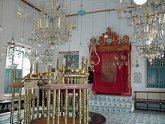 |
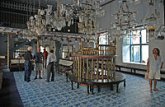 THIS SIDE: Paradesi Synagogue |
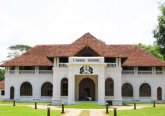 |
 THIS SIDE: Mattancherry Palace |
 |
 |
 |
After returning to Fort Kochi in another tuk-tuk, we said farewell to our guide and sat down to a fabulous lunch at Malabar Junction, the restaurant of Malabar House, a Relais & Chateaux hotel in Fort Kochi.
In due course we used Uber to get back to the Crowne Plaza, where we had time for a spell by the pool prior to sunset. Evening drinks were in the hotel's Skybar. We didn't like it there, thanks to 1980s-type decor and a complete lack of ambience. Dinner at Trilogi was far more successful, and provided a fitting end to a hugely successful day.
| Back at the Crowne Plaza, from left to right: 1. By the pool 2. Skybar 3&4. 'Trilogi' restaurant | |||
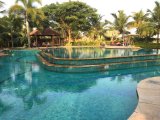 |
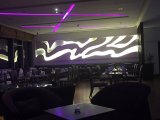 |
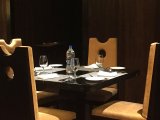 |
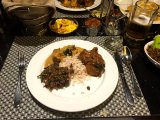 |